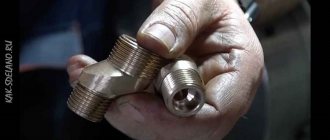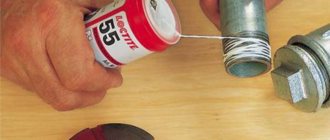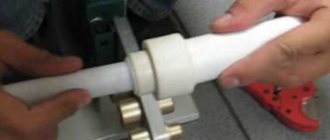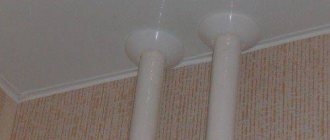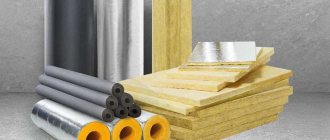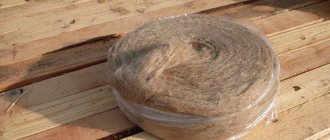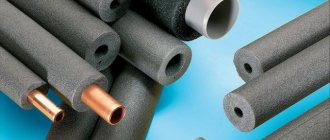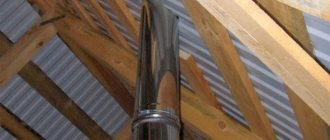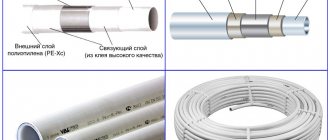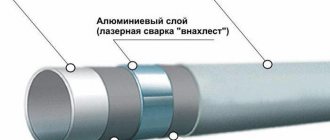The second article in the series “Entertaining plumbing.” As I promised, I’ll tell you about the installation of threaded connections. Further more interesting!!!
Dmitry Belkin
This is the second article in the “Entertaining Plumbing” series. In the first article of the series, I talked about how I drain water from boilers. Today I would like to talk about threaded connections.
Who is this article for?
Having already written the article, I thought - who is it for? First of all, of course, for me, since when I wrote it I had a fair amount of pleasure. Secondly, I think, for people who are not professionals and are “afraid to start.” Well, if professionals read it and like it, then I won’t even be happy, but just happy.
Well, before we start
Let me remind you that I am not a professional, that is, I am self-taught, I have not studied anywhere in my specialty. But I have a lot of experience.
Unfortunately, or maybe fortunately, no one has yet canceled the threaded connections in our water supply system. Personally, at first I was not very pleased with this, since these same threaded connections took up a lot of my time and I could not test each one for reliability in advance. That is, before turning on the water, you must first assemble everything, then check which connections are leaking, then disassemble everything (!!!) and fix it. Now I don’t care, because I somehow learned to feel “by touch” whether the connection will leak or not. Most likely not even “by touch”, but in the process of twisting. But perhaps we’ll talk about this a little later.
Linen seal
Flax is the cheapest sealant, but it is difficult to work with.
Sanitary paste is used to process flax, otherwise it will rot and crumble on the hot water supply (DHW) pipe, and it will rot on the cold water supply (CW) pipe. A water supply threaded connection treated with paste can be adjusted (corrected by turning it backwards) at an angle of up to 45°, parts are easier to screw on, and the thread is protected from corrosion.
Advantages:
- the lowest price;
- flax seals threads of all sizes;
- The surface is suitable in any condition: dirty, wet, rusty, damaged.
Flaws:
- It is difficult and time-consuming to work with linen sealant;
- hands, pipes and instruments are always dirty from flax fibers and paste;
- when tightened and swells, it creates stress in the thread.
Flax is good for sealing connections between metal pipes and fittings, but thin-walled parts and small threads must be handled with care. Of the combined elements, it is better to take those whose plastic part is made of more elastic polypropylene.
It is impossible to seal joints of parts made entirely of plastic with flax - due to the high tightening torque, damage to the walls and thread breakage is possible.
Flax lubricant for sealing threaded joints
Oil paint
But I saw mentions of lubrication in books. In Soviet-era books it was proposed to seal (lubricate) flax with oil paint. And old plumbers successfully use this method. Oil paint, of course, is something. It first lubricates and then glues the joint almost tightly. I encountered one of these. I disassembled one heating system and cursed everything in the world. I had to heat almost every connection to almost red hot. Only then could I unwind it. Let me note that not everywhere you can just use a hairdryer or a torch. There are all sorts of factors, such as wallpaper on the walls, that you don’t want to burn. But it has to.
Silicone sealant
Personally, after encountering oil paint, I realized that I would not use it. I decided to use silicone sealant. I have personally used it myself in my home for both heating and plumbing. And I liked it. The sealant perfectly lubricates the flax. After screwing the coupling (for example), a certain amount of sealant is squeezed out and it can be carefully and even beautifully wrapped around the joint (more precisely, along the side that is formed by the connected parts). And finally, the sealant has the ability to dry, which is also very, very nice.
After I used this sealant, I read a warning that silicone sealant should not be used in threaded connections. That the sealant is an acid that completely corrodes the thread.
I'm happy to report. It's a bullshit! As already mentioned in the announcement of the series, I changed the plumbing that was assembled with silicone 10 years ago. When examining the threads with a magnifying glass, I did not find any (!!!) traces of the sealant acting on the threads. Moreover, the threads under the sealant retained their virgin shine! Another thing is that it was not easy to tear off the flax with sealant from the threads! But even here I very quickly found a way. I cleaned the threads with a thick wire brush. As I already said, the threads under the sealant unscrewed well and remained pristine, which allowed me to reuse many non-ferrous metal parts.
The next two photos illustrate the above, namely that the silicone sealant did not spoil the thread, but, on the contrary, made it better. Even the section of the pipe that was exposed to air was preserved worse than the threads under the sealant (in the case of a galvanized pipe).
Modern materials for sealing (lubricating) flax
Remember I told you about my conversation with a professional? So it was he who told me and showed me a tube of special ointment for sealing threaded joints. I bought one and tried it out. I'll be honest. This is something amazing. The effect is simply amazing. I have now forgotten about silicone sealant forever and ever and I can’t even imagine how I used to live and work.
A modern product for lubricating and sealing flax in threads
Briefly speaking! This ointment is terribly greasy. It doesn't dry out. Its main advantage is that now I can practically not worry about the amount of flax in the carving. That is, now I can twist the thread a little thicker and wind it around the thread a little less carefully. In some way incomprehensible to me, all the flax is crushed and placed into the carving without much effort on my part. I loosened some connections. The linen seems to become part of the carving. The likelihood of damaging the connection has decreased globally. Well, the best part is that despite the significant price of the tube, the ointment consumption is more than modest.
By the way!
I made a video for the first time and posted it on Youtube. Direct link to it: Direct link to the video on Youtube
It turned out to be almost impossible to remove the used thread from the thread without the help of a wire brush.
Spun connection (the one made in the movie)
Please note that all threads lie completely in the grooves in which they are needed. As I said, the flax has practically grown into the carving. This means the connection was extremely reliable.
I believe we owe this effect entirely to the super sealant from the tube
Bad threaded connection
But, on the contrary, an unsuccessful connection. It was made “with silicone sealant.” Please note that the flax went a couple of turns and then began to crumple like an accordion. And yet the connection stood for 10 years and would stand for who knows how long. Probably forever. And we recorded the quality only when we untwisted the connection.
FUM tape
FUM tape is suitable for small undamaged threads.
Advantages of fluoroplastic sealing material:
- soft, parts are easy to screw in and unscrew, you don’t have to worry about breaking or cutting new threads with metal on plastic due to strong compaction;
- The cleanliness of the threaded surface does not matter;
- almost doesn't get dirty.
Flaws:
- even with a slight displacement of the connection, leakage is possible;
- If the thread is tightened incorrectly, it is impossible to align the thread by feeding it back; an attempt will lead to leakage; the connection can only be disassembled and reassembled by re-winding the tape.
For beginners, FUM tape for sealing water pipes creates the most problems. It is advisable to use it in temporary engineering systems or where a slight leakage is not critical, for example, in a country water supply system.
Parts made of any material with medium-sized threads in good condition are suitable for sealing. The material is safe when sealing thin-walled fittings. It is contraindicated to seal threads on a water pipe with tape in case of possible shifts, in the area of impact loads or vibration.
Using the Record winder: step-by-step instructions
1.
Attach the first turn to the edge of the fitting in the thread groove.
2.
Make a cross-shaped winding as you cut. It is advisable to do this in such a way that the winding is thicker in the middle and thinner at the edges.
3.
Do the installation. If the winding has been completely squeezed out, disassemble and rewind.
4.
If the connection requires positioning or adjustment, the seal will remain tight until it is rotated 180 degrees.
Read material on the topic: “American” in plumbing: advantages and applications
Plumbing thread
Plumbing thread is suitable for sealing pipes with any thread and in any condition.
It consists of polyamide microfibers coated with silicone. Very durable, impossible to tear with your hands.
Advantages:
- seals any thread equally well: old, corroded, wet, damaged;
- After compaction, adjustment up to 180° is possible;
- the tightening torque is less than when using flax, it is easy to assemble and disassemble;
- less FUM tape gets dirty.
Disadvantage: several times more expensive than flax, the price is comparable to FUM tape.
Even a non-professional can work with thread; technically, it is the simplest sealant. Can be used without restrictions on all types of connections, especially convenient for threads with fine pitches. For plastic parts, the thread must be used quite carefully.
How to rewind
Let me make a reservation right away: maybe someone performs this operation differently. But I can say with confidence: the connection is sealed and reliable.
Take a small bunch of flax, approximately as in the photo below, this is for winding a half-inch pipe (“1/2”). In general, the ability to take exactly as much flax as is needed for a particular connection comes with experience. One thing I can say for sure: it is better to overdo it than to take less than necessary.
The flax is wound onto the thread from the edge to the base, in the direction of the thread. If you look at the end, it turns out clockwise. It’s not important to get into every hole and go strictly in a spiral. The direction of winding, tension and that the threads are covered with an even layer of flax over the entire surface are important.
You can even lay the winding in several layers if the bundle is initially taken too thin.
The main thing is to take as a rule: no matter how much flax is wound, you need to try to evenly distribute the fibers, without empty threads.
Sometimes there are very smooth threads, for example on water meters, the flax scrolls when winding. To eliminate this unpleasant phenomenon, it is enough to lightly scratch the thread, for example, by lightly walking across the threads with a sharp knife. Even barely noticeable burrs and scratches can firmly stop flax fibers from spinning.
Next, the wound area should be generously lubricated with investment paste. Even if you overdo it, the paste is easily removed after tightening the parts. The parts are ready for twisting.
Silicone tape
Using silicone tape, you can instantly eliminate a leak.
It combines the advantages of these materials. It differs better from FUM tape in its resistance to vibrations and the ability to adjust at an angle of up to 180°.
Flaws:
- cannot be used on narrow and thin threads;
- costs much more than thread and FUM tape.
It is recommended to use silicone tape to seal water pipes and fittings made of metal and plastic with large threads.
Conclusion
The use of a biodegradable plant-based material such as flax is completely unjustified in the age of polymer piping. Metal threads are still subject to corrosion and destruction when flax swells, so most of the benefits from the use of polymers in pipeline systems can be neutralized by the mere presence of flax as a sealant. The emerging shift away from the use of plant materials is quite natural and justified. The consumer wants to delve less into installation technology and wants to receive quality regardless of the season and the qualifications of the plumber. Choose the right polymer materials
,
the disadvantages of which are not associated with the risk of loss of tightness
, such as anaerobic gels or sealing thread. Thanks to them, pipelines, even those made of ferrous metal, will serve reliably season after season - for many years.
Prepared based on materials:
Authors of the article: Kozlov V.M., Kozlov E.V.
Anaerobic adhesive sealant
The latest generation of sealant hardens only after twisting and hardens within 20 minutes.
The viscosity, hardening speed and fixation strength of the compositions vary. The thinner the glue, the smaller the thread it is designed for. The connection, mounted using a strong anaerobic sealant, can be disassembled only when heated.
Advantages:
- fastest installation;
- assembled without keys, with just one hand;
- fills the entire inter-threaded space;
- when tightening, no distortion occurs, the load on the thread is transferred evenly;
- before setting begins, adjustment to any angle is possible;
- the connection does not have to be tightened, as is the case with flax, ribbons or thread;
- there are no protruding parts of the seal;
- protects against corrosion;
- resistance to increased water pressure.
Flaws:
- the most expensive seal;
- the junction must be perfectly clean and grease-free;
- You can use the water supply only after the sealant has cured;
- difficult disassembly of the connection;
- after heating during dismantling, a leak may occur at the junction of dissimilar materials;
- Gets your hands dirty.
Used for assembling new threaded connections made without the use of lubricant. Anaerobic sealant for water supply pipes is convenient for installing connections in hard-to-reach places. Considering the complexity of disassembly, it is better to use for units that are not planned to be disassembled.
Non-hardening pastes
Another suitable sealant for gas or other pipes is a special non-hardening paste in the form of a viscous substance based on synthetic resins, acrylic and silicone, oils and various fillers. Such products are very easy to use: they need to be applied to the threads and the pipes are connected.
Positive qualities of pastes:
- the presence of additives against metal rusting;
- quick and easy thread tightening;
- easy dismantling of the system;
- no thread jamming during assembly.
Unfortunately, such pastes are only suitable for pipes under low pressure. If the pressure is high, the composition will soon be squeezed out of the thread. You should also not rely on strong fixation of pipes, as well as on the resistance of the products to sudden changes in temperature or the effects of aggressive chemicals.
It is best to use non-hardening pastes with flax or artificial threads to increase the reliability of the joint.
Cold welding
A plasticine-like two-component composition based on epoxy resin, when connecting both parts, turns into a strong glue.
Advantages:
- some types of cold welding can be applied to a wet surface and under water;
- the resulting mass can be given the desired shape and processed after hardening.
The disadvantage is the high price.
Cold welding is indispensable when it is necessary to eliminate a leak, but there is no time for disassembly or the possibility of shutting off the water supply. Usually this solution is temporary.
Cold welding can restore a thread or a broken part. It is enough to apply the mixture to the damaged area, screw it on, and then unscrew the joining element and wait for it to cure.
O-rings and seals
Rubber sealing rings are used to seal faucet axle boxes, fittings and hoses with a union nut.
They are used if one of the parts has a limiting collar into which the end of the second rests. A gasket is placed between the contacting surfaces if the collar is internal, and a ring if it is external. Thread sealing is not required; on the contrary, this is considered an error.
It is better to use rings and gaskets made of soft silicone for cold water supply, and in the hot water supply system it is better to install seals made of heat-resistant rubber or paronite.
The advantage is the speed of installation: just install the gasket or put on the ring and tighten it. Disadvantage: due to the requirement for a collar, they are used in a narrow segment.
Rings and gaskets are used to seal connections when installing fittings and hoses with a union nut, and faucet axle boxes in mixers.
None of the materials considered can replace all the others. It is always better to keep a set of several seals on hand and use them depending on the situation.
Sealing of household air ducts
Ventilation in apartments and country houses is carried out using thin-walled elements. Often, air ducts are made of rectangular cross-section or from corrugated pipe. Threading on such connections is not possible. Therefore, sealing ventilation joints is carried out in other ways:
- through flanges,
- applying a bandage,
- using the socket method by inserting one air duct into another.
A flange connection is most often used for non-circular ducts. Sealing is carried out using gaskets made of soft material, for example, porous rubber. The shape of the gasket must match the cross-section of the air duct.
With other methods, the voids formed after joining the air ducts are filled with mastics whose temperature characteristics correspond to the operating conditions of the air line. Sometimes the joint of the air ducts is wrapped with self-adhesive tape.
Bandage clamps used for joining round air ducts
*
